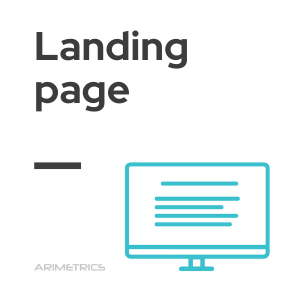
Definition:
A landing page is a web page specifically designed to capture the user’s attention and guide them toward a specific action. Unlike other web pages, blogs, or articles, landing pages are usually linked from ads or external links and are not typically the main page of a website.
Characteristics of Landing Pages
Landing pages are distinguished by their focus on a specific goal, often related to converting visitors into potential customers or generating leads. Unlike the main page of a website, which may present multiple links and navigation options, a landing page is designed to minimize distractions and focus the user’s attention on a single action. This can include filling out a form, subscribing to a newsletter, downloading a resource, or making a purchase.
Landing pages eliminate unnecessary elements such as navigation bars or additional links that could divert the visitor from the desired action. Their design is optimized for simplicity and clarity, ensuring that the message and call to action are direct and effective.
Purpose of a Landing Page
The main purpose of a landing page is to convert visitors into leads or customers by guiding them toward a specific action. These pages are particularly effective when traffic comes from ads or specific sections of a website or blog that align with the user’s expectations and interests.
Unlike informational or one-way communication pages, landing pages are designed to encourage interaction and improve the conversion rate. By eliminating distractions and focusing on a clear value proposition, these pages increase the likelihood that the visitor will take the desired action, thereby improving the effectiveness of digital marketing campaigns.
Key Elements of an Effective Landing Page
To maximize the effectiveness of a landing page, it is essential to include certain elements that guide the user toward conversion:
- Clear and compelling Headline: The headline should immediately capture the visitor’s attention and communicate the value of the offer concisely.
- Value proposition: Clearly explain what benefits the user will gain by completing the desired action.
- Prominent Call to Action (CTA): The CTA should be visible and persuasive, using language that motivates the user to act.
- Relevant images and videos: Visual elements can reinforce the message and make the page more appealing.
- Social proof: Including customer testimonials, reviews, or success stories can increase credibility and trust in the offer.
- Data capture form: If the goal is to collect user information, the form should be brief and only request essential data.
Common Mistakes in Landing Pages and How to Avoid Them
When designing a landing page, it’s important to avoid mistakes that can reduce its effectiveness:
- Too many cistractions: Including too many links or irrelevant information can divert the user from the desired action.
- Lack of consistency with the Ad: Ensure that the content and design of the landing page are consistent with the ad or link that brought the user to the page.
- Inconspicuous CTA: A call to action that doesn’t stand out or is difficult to find can reduce conversions.
- Slow Page Load Time: Pages that take too long to load can frustrate users and increase bounce rates.
- Not conducting A/B Tests: Failing to test different versions of the page can lead to missed optimization opportunities.
